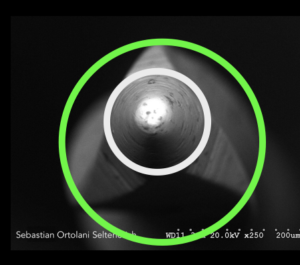In general, nickel-titanium instrumentation systems have a non-cutting tip which renders it inactive. The purpose is to enable the tip to follow the glide path rather than actively cut and risk ledging or torsional failure/fracture if the canal wall is inadvertently caught and the tip locks. The Booster tip designed by FKG Dentaire is analogous to a very finely sharpened lead pencil (Figs 1a, 1b).

Fig 1a

Fig 1b
The lead section enters canal ensuring fits into the pre-established glide path ensuring precise guidance and centering of the instrument. A traditional glide path instrument is consistent with a #15/.02 (size/taper) instrument. There are no cutting flutes on this section and the instrument slips into the prepared apical component of the glide path to a depth of ¼ mm. The next ¼ mm section of the Booster tip is configured 6 cutting flutes. Rotation of these flutes sizes the next ¼ of a mm of the canal space anywhere from a #25/.02 to #60/.02 (size/taper) instrument. The apical size can be verified with a SS file to ensure the apical terminus will accommodate the commensurate gutta-percha cone used in the cold hydraulic obturation technique.

Fig 2
Thus, after glide path creation, with very simple manipulation, the final sized file to the apical terminus, #25/.02 or more, is ½ of a mm coronal to the CDJ as determined by the foramenal locator. The most apical ¼ mm acts as a “sprue” component to ensure the bioceramic sealer flows without an impediment into the apical seat. Figure 3 shows the difference between a normal tip configuration and the innovative BOOSTER TIP.

Fig 3
The Booster Tip is present on the XPendo Shaper – this revolutionary adaptive/virtual core file enables the clinician to shape the entire canal to a #30/.02 to. 04 or .06 depending on the number of swaths of the canal used to sculpt the inner anatomy. The repeated use of the shaper allows the canal to yield to a taper size consistent with the intra-canal dentinal anatomy and hardness. Should the XPendo Shaper not go to working length, then the glide path can be reproduced with copious irrigation, the XPendo Shaper swaths repeated and invariably with 3 to 5 swaths, the working length is reached.
No instrument of any kind is ever pushed or forced to achieve length. Stop, irrigate, recapitulate and repeat the sequence. It is imperative as well that an understanding of the air bubble in the apical terminus causing vapour lock be understood. To irrigate the last few mm of any canal, the size of the terminus is an imperative. Anything less than #30 will not allow irrigant to penetrate due to vapour lock.
The design of the Booster tip enhances the minimally invasive nature of the XPe Shaper which due to its adaptive/virtual core design can alter the canal taper to a #30/.04 or .06 if necessary. The taper is achieved by the number of in and out swaths delivered provided this doesn’t go beyond 30 seconds and engender cyclic fatigue. In this way while ensure minim beyond 30 seconds – cyclic fatigue. The dentin remains maximally strengthened……the dentinal girth in the coronal 1/3 is maintained and the new cold hydraulic bioactive ceramic fillers can be used optimize obturation.

